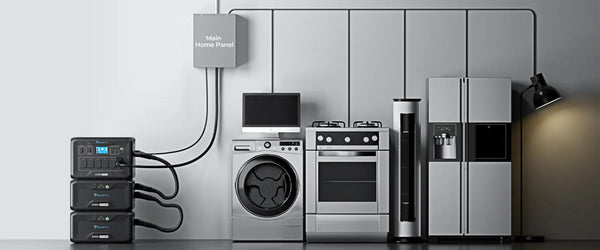Two battery technologies have emerged as frontrunners in the ever-evolving energy storage and portable power solutions: LiFePO4 vs. Lithium Ion. Understanding the nuances of these battery types is crucial when making informed decisions for various applications, from renewable energy storage to powering your portable devices.

LiFePO4 Battery: A Sustainable Powerhouse
LiFePO4 battery represents a groundbreaking innovation in battery technology. Unlike traditional lead-acid batteries, LiFePO4 batteries are a greener and more sustainable choice. These batteries are renowned for their exceptional energy density, long cycle life, and inherent safety features.
A distinguishing characteristic of LiFePO4 batteries is their iron phosphate cathode, which offers remarkable stability and resistance to thermal runaway, making them a safe choice for various applications. The electrodes within a LiFePO4 cell have a 3D structure, improving their electrochemical performance and overall lifespan.
Lithium-Ion Battery: A Versatile Power Source
Lithium-Ion batteries have revolutionized the portable electronics industry and have found applications in various fields, from electric vehicles to grid-scale energy storage. These batteries are highly energy-dense, lightweight, and capable of providing a consistent and reliable power supply.
One of the key features of Lithium-Ion batteries is their versatility. They come in various chemistries, including lithium cobalt oxide (LiCoO2), lithium manganese oxide (LiMn2O4), and lithium nickel cobalt manganese oxide (LiNiCoMnO2), each catering to specific requirements and applications. However, it's important to note that LiFePO4 batteries fall under the broader category of Lithium-Ion batteries.
Common Features of LiFePO4 and Lithium-Ion Batteries
Before delving into the differences, let's explore the common features shared by LiFePO4 vs. Lithium-Ion batteries:
High Energy Density: Both battery types offer high energy density, allowing for compact and lightweight designs.
Rechargeable: LiFePO4 and Lithium-Ion batteries are rechargeable, enabling multiple charge and discharge cycles.
Low Self-Discharge Rate: These batteries have a low rate, meaning they can retain their charge for extended periods.
Wide Operating Temperature Range: LiFePO4 and Lithium-Ion batteries can operate in a broad temperature range, making them suitable for various environments.

Differences between LiFePO4 and Lithium-Ion Batteries
Now, let's explore the distinctive characteristics that set LiFePO4 vs. Lithium-Ion batteries apart:
Safety
LiFePO4 batteries are a safer choice than Li-ion batteries, primarily owing to the robust covalent bonds between the iron, phosphorus, and oxygen atoms within the cathode. These bonds impart a heightened level of stability and significantly reduce the likelihood of thermal runaway and overheating, which are concerns that have contributed to Li-ion batteries being associated with a higher risk of battery fires.
This enhanced stability is precisely why LiFePO4 batteries have become the standard in off-grid and solar power applications. In residential settings, where any overheating or safety issues are unacceptable, homeowners can confidently store their LiFePO4 batteries indoors without worrying about fire hazards.
Energy Density
Li-ion batteries generally exhibit a higher energy density than LiFePO4 (LFP) batteries. Energy density measures the energy a battery can store per unit of volume or weight. Li-ion batteries are known for their ability to store more energy per unit of volume or weight when compared to LFP batteries.
For instance, a typical Li-ion battery has an energy density ranging from approximately 45 to 120 watt-hours per pound (100-265 Wh per kilogram), whereas a LiFePO4 battery's energy density is approximately 40 to 55 watt-hours per pound (90-120 Wh per kilogram). It's important to note that this broad range of energy densities for Li-ion batteries encompasses various Li-ion battery technologies, some specifically tailored for electric vehicles and other specific applications.
However, when it comes to off-grid power solutions, LiFePO4 batteries continue to excel, even though they may have a slightly lower energy density when compared to Li-ion batteries. This difference becomes negligible, particularly as you consider larger stationary power solutions, where the focus shifts towards durability, cycle life, and safety rather than just energy density.
Weight
The weight of a battery bank does have some association with energy density, as previously discussed. LiFePO4 (LFP) battery banks might exhibit a slightly higher weight than equivalent Li-ion batteries. However, there are instances where certain LFP batteries are lighter due to the usage of lighter metals in their construction.
Nevertheless, any minor variation in weight becomes insignificant when juxtaposed with the substantial advantages that LFPs offer. In off-grid and solar applications, Li-ion batteries with higher energy densities, such as nickel-cobalt-aluminum (NCA) and nickel-cobalt-manganese (NCM), are no longer considered the ideal choice. Instead, residential power solutions opt for safer and longer-lasting technologies like LiFePO4. In such applications, the emphasis is placed on safety rather than the marginal difference in weight.
Temperature Range
LiFePO4 batteries boast a broader operational temperature range, functioning optimally in temperatures spanning from a frigid -4¡ãF (-20¡ãC) to a scorching 140¡ãF (60¡ãC). In stark contrast, Li-ion batteries are considerably more sensitive to temperature fluctuations, with their operational range limited to a narrower spectrum, from 32¡ãF (0¡ãC) to 113¡ãF (45¡ãC). Consequently, users of Li-ion batteries must ensure they are stored in temperature-controlled environments during extreme cold or heat.
LiFePO4 batteries, on the other hand, offer flexibility and safety that allow them to be stored indoors, be it in a house, shed, garage, or any other indoor space, without air conditioning. Their resilience to temperature variations allows users to choose their battery's location without the concerns of potential damage or diminished efficiency.
Lifespan
Regarding lifespan, the disparity between LiFePO4 and Li-ion batteries is striking. While many Li-ion batteries tend to endure around 500 charge and discharge cycles before experiencing performance degradation, LiFePO4 batteries can withstand thousands of such cycles before exhibiting a noticeable performance decline.
This significantly extended lifespan characteristic of LiFePO4 batteries translates to longer-lasting power solutions and contributes to reducing the environmental impact stemming from electronic waste. Furthermore, LiFePO4 batteries, lacking nickel and cobalt, emerge as a more environmentally friendly choice. Investing in a LiFePO4 battery bank means you can rely on its performance for five to six times longer than a Li-ion model, eliminating the need for frequent replacements and, subsequently, unnecessary expenses.
Cost
The cost per watt-hour of LiFePO4 and Li-ion batteries can exhibit substantial variations, contingent upon factors such as the manufacturer, market demand, and capacity. It's important to note that LiFePO4 batteries do not incorporate nickel or cobalt, materials notorious for their erratic supply and price fluctuations.
While LiFePO4 remains a relatively novel battery chemistry, translating into fewer manufacturers and potentially higher costs per watt-hour than Li-ion counterparts, affordable options for LiFePO4 batteries are available. Even if there is a marginal cost difference compared to comparable Li-ion battery packs, the advantages that LiFePO4 batteries offer in terms of safety, prolonged lifespan, and other invaluable benefits far outweigh this price disparity.
Self-Discharge Rate
LiFePO4 batteries exhibit a commendably low self-discharge rate, estimated at approximately 1-3% per month, contingent upon usage, temperature conditions, and other variables. This low self-discharge rate provides the convenience of long-term storage without concerns of substantial power loss, ensuring that the battery remains a potent energy source even after extended periods of disuse.
To adhere to best practices, it is advisable to top off your LiFePO4 battery at least every few months to maintain its optimal performance when needed.
Voltage
LiFePO4 batteries feature a nominal voltage lower than that of Li-ion batteries, typically hovering around 3.2V per cell in contrast to Li-ion batteries, which typically range from 3.6V to 3.7V per cell. This voltage differential can have implications for the design of battery packs and the voltage requirements of devices utilizing them, necessitating consideration of compatibility when selecting a battery for specific applications.
Application for LiFePO4 and Lithium-Ion Batteries
LiFePO4 vs. Lithium-Ion batteries find applications in various industries and use cases. Here are some common scenarios in which these batteries are employed:
Renewable Energy Storage
LiFePO4 batteries are ideal for renewable energy storage solutions, such as solar power systems and wind turbines. Their durability, long cycle life, and safety features make them an excellent choice for storing excess energy generated during the day for use at night.
BLUETTI LiFePO4 Battery
When considering LiFePO4 batteries for solar energy storage, the BLUETTI AC500+B300S Home Battery Backup system is a reliable solution. Its LiFePO4 battery technology ensures efficient energy storage and delivery for your residential needs, enhancing sustainability and reducing energy costs.

Electric Vehicles (EVs):
Lithium-Ion batteries are the go-to choose for electric vehicles due to their high energy density and lightweight nature. They offer the range and performance required for EVs to compete with traditional internal combustion engines.
Portable Electronics:
Lithium-Ion batteries power many portable devices, including smartphones, laptops, tablets, and cameras. Their energy density and fast-charging capabilities are essential for modern consumer electronics.
Marine Applications:
LiFePO4 batteries are increasingly used in marine applications, providing reliable and safe power for boats and yachts. Their resistance to temperature extremes and durability makes them a preferred choice for marine enthusiasts.
FAQs about LiFePO4 vs. Lithium-Ion
Are Li-Ion and LiFePO4 the same?
No, LiFePO4 vs. Lithium-Ion batteries are not the same. LiFePO4 batteries are a subset of Lithium-Ion batteries, characterized by their iron phosphate cathode and enhanced safety features. Traditional Lithium-Ion batteries can encompass various chemistries with different characteristics.
What are the disadvantages of LiFePO4?
While LiFePO4 batteries offer numerous advantages, they do have some limitations. These include a slightly lower energy density than other Lithium-Ion chemistries, higher initial cost, and a slightly heavier weight.
Is LiFePO4 cheaper than lithium-ion?
In most cases, LiFePO4 batteries are more expensive upfront than traditional Lithium-Ion batteries. However, their longer lifespan and safety features can result in cost savings over the battery's lifetime.
Which is better, lithium-ion or LiFePO4, in an RV?
The choice between Lithium Ion and LiFePO4 batteries for an RV depends on your specific needs and budget. LiFePO4 batteries are safer and have a longer cycle life, making them suitable for RVs requiring reliable and durable power sources. However, Lithium-Ion batteries may be preferred for their lightweight design if weight is a crucial factor in your RV setup.
Conclusion
In the ever-evolving world of battery technology, choosing between LiFePO4 vs. Lithium-Ion batteries boil down to your specific requirements and priorities. LiFePO4 batteries excel in safety, long cycle life, and stability, making them an excellent choice for renewable energy storage and applications where safety is paramount.
On the other hand, Lithium-Ion batteries offer versatility and fast charging capabilities. They are often more budget-friendly, making them suitable for various applications, from electric vehicles to portable electronics.
When considering LiFePO4 batteries for solar energy storage, the BLUETTI AC500+B300S Home Battery Backup system emerges as a reliable and sustainable solution. Its use of LiFePO4 battery technology ensures efficient energy storage and delivery, contributing to a greener and more cost-effective future.



